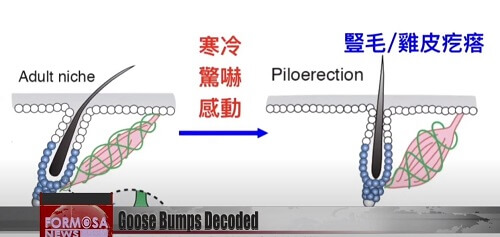The Arrector Pili Muscle (aka Goosebump Muscle)
Update: August 7, 2020 — Yesterday, Taiwanese and US researchers published an important paper titled: “Cell Types Promoting Goosebumps Form a Niche to Regulate Hair Follicle Stem Cells.” The work was led by Dr. Lin Sung-jan of National Taiwan University. In collaboration with researchers from Harvard University (US).
Goosebumps, the Sympathetic Nervous System and Hair Growth
Lin’s team found that the biological mechanism behind baldness in men is closely connected to the sympathetic nervous system. Hair follicle stem cells activate after receiving signals via what are known as ADRB2 receptors. Based on these findings, the researchers hope to develop small molecule drugs that can activate ADRB2 receptors as a means of regenerating hair.
Goose bumps are a sympathetic nerve response involving the contraction of tiny muscles all over our bodies. These arrector pili muscles causes hair to stand up straight on the skin when we are fearful and under threat. The scientists aim to ultimately control the muscle-nerve system that drives hair regeneration. A video of these findings was published here. It is quite something to see Dr. Lin Sung-jan being mobbed by the media.

Jan 10, 2017
Several weeks ago, the arrector pili muscle got significant coverage in a few newspapers around the world. Famed Australian dermatologist Dr. Rodney Sinclair co-authored an important paper titled “The arrector pili muscle, the bridge between the follicular stem cell niche and the interfollicular epidermis” that was just published this month.
Dr. Sinclair has been involved in this area of hair loss research for a few years and already published similar findings several times in the past decade, including material on his own site. Nevertheless, Australian newspapers were especially interested in this latest study and its findings as evidenced by articles such as this one and this one.
The Arrector Pili Muscle
Arrector pili muscles are small muscles attached to individual human hair follicles on both the scalp as well as body (so we have millions of these muscles throughout our bodies). Contraction of these muscles causes hairs to stand up, a phenomenon that is known as goosebumps. Therefore, the musculus arrector pili is often referred to as the goosebump muscle.
Every hair root is connected to the arrector pili. This smooth muscle contracts in response to signals from the “fight or flight” sympathetic nervous system.
The Arrector Pili Muscle Degeneration and Hair Loss
In recent years, a few studies have come out that suggest a possible connection between the arrector pili muscle degenerating (where it gets replaced by fat) and hair loss due to the subsequent disconnection between various hair follicle stem cell populations. It is possible that an intact arrector pili muscle plays a crucial role in the maintenance of follicular integrity and stability.
However, there are many uncertainties about this theory that I discuss in the next section. It seems that while in alopecia areata (AA) patients the arrector pili muscle remains intact, this is not true in androgenetic alopecia (AGA) patients (and unfortunately over 95 percent of balding men suffer from AGA). So this could be why it is much easier to grow back hair for people with AA compared to people with AGA. However, the rate at which the arrector pili muscle degenerates and gets replaced by fat varies substantially between patients and between individual hairs on the same scalp. Some miniaturized vellus hairs in balding regions might even never lose most of their arrector pili muscle connection.
Points of Contention
- According to Dr. Sinclair’s own quote from a past paper, “It remains unclear whether arrector pili muscle regression is a cause or effect of permanent follicle miniaturization“. I think this is the crux of the issue surrounding this theory/hypothesis.
- It seems like hair that is transplanted from the back of a person’s scalp to the front of that same person’s scalp regenerates the arrector pili muscle. A very important related study from 2012 comes to us from Japan. So it might be very possible to regenerate this muscle.
- In Dr. Tsuji and his team’s groundbreaking technology (hoped to be released in 2020): “the transplanted primordium also forms connections with surrounding tissues (arrector pili muscle and nerves) and repeats normal hair cycles”.
- There are 100s of anecdotal reports on the internet of people regrowing long-lost hair in bald scalps. On the internet, you can find many reports of old men who recently started taking dutasteride for enlarged prostate issues and have subsequently noticed hair regrowth on areas of their scalps that have been totally devoid of any visible hair for decades. Maybe they regenerated their arrector pili muscles; or maybe those muscles always remained intact in spite of severe AGA; or maybe one can regenerate hair without the need for having any intact arrector pili muscles?
- It is unclear when exactly we have a point of no return where the arrector pili muscle is largely or entirely replaced by fat and hair stops growing (either as a cause or effect — see first bullet point above). It seems like there is significant variation depending on person and hair follicle. In many cases, the arrector pili might not be entirely degenerated and replaced by adipose tissue even in areas of the scalp where one has been bald for several decades. In such cases, subsequent hair and muscle regeneration could perhaps even be possible via something like Dutasteride or Finasteride?
The post The Arrector Pili Muscle (aka Goosebump Muscle) appeared first on Hair Loss Cure 2020.
